85 years of boating history
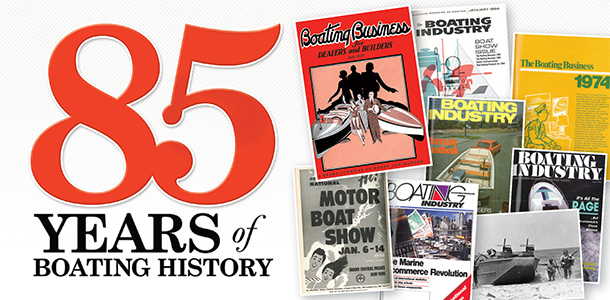
A look back at more than eight decades of the boating industry
It was 85 years ago this month that Boating Business was launched as “The Trade Journal of Boats and Motors.” The forerunner of Boating Industry was the first trade magazine for those in the industry — “the men whose bread and butter depend on their ability to sell boats and motors,” publisher James W. Peaslee wrote at the time.
Below we’ve picked out some highlights from the ensuing decades.
1920s/30s
The first issue of Boating Business was published mere months before the October 1929 stock market crash. Despite the ensuing Great Depression, the late 1920s and 1930s were formative years for the industry we know today.
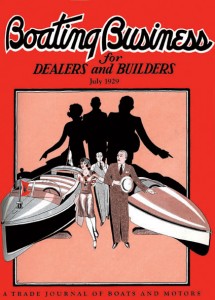 For the first time, those in the industry started to organize, with the formation of the National Outboard Association and the Marine Trade Association. One of the boating industry’s longest-lasting companies was formed in 1929 when Evinrude, Elto and Lockwood merged into the Outboard Motors Corporation. Johnson Motor Co. would be absorbed by OMC in 1936.
For the first time, those in the industry started to organize, with the formation of the National Outboard Association and the Marine Trade Association. One of the boating industry’s longest-lasting companies was formed in 1929 when Evinrude, Elto and Lockwood merged into the Outboard Motors Corporation. Johnson Motor Co. would be absorbed by OMC in 1936.
Mercury Marine was born in the 1930s when Carl Kiekhaefer started the Kiekhafer Corp. in Cedarburg, Wis., in 1939. The 1930s also saw the first boat shows in Los Angeles, Chicago and Dallas, to name just a few cities.
By 1932, signs of the depression were finding their way into the pages of the magazine, with boat and engine manufacturers promoting their new lower prices and articles with headlines like “Is the slump in your head?” For instance, Wild Ducks Inc. introduced the “Depression Boat,” with the promise of extra profits for its dealers. Chris-Craft announced its “Prosperity Program” of more support for its dealer network and a large national advertising campaign.
The May 1932 issue included an appeal to yacht owners, urging them to have work done on their vessels to combat unemployment. The appeal was part of the War Against Depression Campaign launched by The American Legion and American Federation of Labor.
While that campaign didn’t seem to take off, the boating industry did benefit from several other public works programs during that time, from the creation of the Lake of the Ozarks to numerous waterfront improvements included as part of recovery efforts.
While the country and boating industry wouldn’t really recover until World War II, the end of the decade saw signs of improvement, with boat builders announcing wage raises and increased production schedules. The Chicago Boat Show boasted attendance of more than 40,000 in 1939, a record for that show and “probably a record crowd for any boat show, anywhere in history.”
After Boating Business ceased publication in December 1937, founder James Peaslee (who had sold the magazine) relaunched it in January 1938 as The Boating Industry.
1940s
Although it began in 1939, World War II defined nearly every aspect of the 1940s, including the marine industry. After Pearl Harbor was bombed by the Japanese military on December 7, 1941, the United States threw itself and its resources into the war effort.
Sixteen million Americans joined the fight, critical resources were rationed and factories were converted to producing armaments, vehicles, and everything needed to battle the Axis powers. This massive build-up quickly pulled America out of the Great Depression, and most of the marine industry turned its attention to building boats for the U.S. military. At one point, General Eisenhower requested that Nautique build 400 boats in fifteen days — far more than the company ever produced in such a timeframe. The 1940s saw more changes sweep across the globe than any previous or subsequent decade in history.
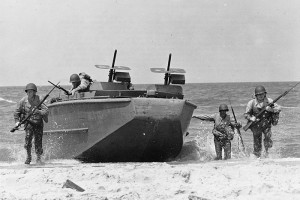 Crucial WW2 mile markers included President Franklin D. Roosevelt’s death on April 12, 1945, the Invasion of Normandy on June 6, 1944, Hitler’s suicide on April 30, 1945, the German surrender on May 7, 1945, the bombings of Hiroshima and Nagasaki, Japan, on August 6 and 9, 1945, and the surrender of the Japanese forces on August 14.
Crucial WW2 mile markers included President Franklin D. Roosevelt’s death on April 12, 1945, the Invasion of Normandy on June 6, 1944, Hitler’s suicide on April 30, 1945, the German surrender on May 7, 1945, the bombings of Hiroshima and Nagasaki, Japan, on August 6 and 9, 1945, and the surrender of the Japanese forces on August 14.
Following the homecoming of U.S. troops, boat shows restarted as boat builders and accessory makers began to revert back to civilian production. The following years saw a transition back to normalcy accompanied by a boom in childbirths, industrial expansion and consumer spending.
Resources remained scarce, including an aluminum shortage that forced Aluma Craft to limit its production in 1947. The Miami Boat Show, first held in 1941, resumed in 1947. Chris-Craft purchased a plant in Chattanooga, Tenn., near the Tennessee River, which was reshaped by the 12 hydroelectric projects of Tennessee Valley Authority.
As the 1940s drew to a close, the United States became the factory of the world, and boating usage and profits surged along with the growth in the consumer economy.
OMC announced a $5.7 million increase in sales in the May 1947 issue of Boating Industry. In 1948, the Coast Guard reported that the number of registered motorboats in the U.S. reached 440,000 with an upward trajectory.
The 1940s had changed the world order, and the marine industry thrived with exploding sales, new companies entering the business and technological innovations that made boating easier, more fun and available to a wider audience of Americans than ever before.
1950s
Like many U.S. industries, boating boomed in the post-war years. The GI Bill, rising middle class, baby boom and growing suburbs all played a role in the burgeoning marine industry.
In 1950, The Boating Industry reported that there were just less than 450,000 numbered (registered) motorboats in use. By 1959, the industry was selling that many boats in a year.
 The biggest challenge for the marine industry seemed to be keeping up with demand. Throughout the early 1950s the magazine reported on the shortage of metal slowing production as the National Production Authority limited the amount of steel, aluminum and copper available for consumer goods.
The biggest challenge for the marine industry seemed to be keeping up with demand. Throughout the early 1950s the magazine reported on the shortage of metal slowing production as the National Production Authority limited the amount of steel, aluminum and copper available for consumer goods.
That shortage of metal parts led to a resurgence in wood boats and the growth of fiberglass as a hull material. In 1955, even Chris-Craft began building fiberglass boats.
As the post-war restrictions were lifted, though, the industry achieved record growth. By the end of the decade, employees at boat builders and engine makers were working triple shifts five or six days a week to keep up with demand.
In recognition of the 50th anniversary of the recreational boating industry in 1954, The Boating Industry conducted a reader survey. In that survey, 96 percent of respondents said boating was “on in the increase” in their area, with the average reader reporting a 30 percent increase in business over the previous year.
Boat shows continued to grow and the decade saw the first Fort Lauderdale Sports & Boat Show, while in 1953 the Miami Boat Show became “International” for the first time.
In 1954, the American Boat & Yacht Council held its first meeting in New York City, with Phelps Ingersoll elected as president. It described its mission “to develop and make available recommended practices and engineering standards for improving and promoting the design, construction, equipage and maintenance of small craft with reference to their safety.”
Two of the iconic brands in the industry were also created in the 1950s. In 1955, J. Orid Edson founded Advanced Outboard Marine, the company that would become Bayliner after he paid $100 to acquire the name from another company in 1960. And in 1959, Sea Ray was born when C.N. Ray founded the company in Detroit.
1960s
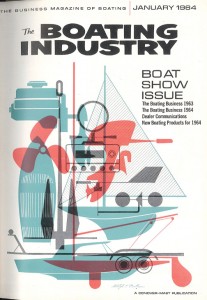 The Sixties have a well-deserved legacy as the most formative decade in recent memory for social upheaval, national tragedies, the expansion of civil rights, the start of the Vietnam War, Woodstock and Cold War tensions that nearly boiled over.
The Sixties have a well-deserved legacy as the most formative decade in recent memory for social upheaval, national tragedies, the expansion of civil rights, the start of the Vietnam War, Woodstock and Cold War tensions that nearly boiled over.
At the decade’s dawn, the U.S. was in a 10-month recession that preceded a massive cycle of prosperity. For the January 1960 issue, The Boating Industry ran a special issue that included boating statistics put together in concert with the National Association of Engine & Boat Manufacturers and the Statistical Research Department of the Outboard Boating Club of America.
As of 1960, boating was the nation’s top family sport with 39 million Americans participating and $2,475,000,000 spent at the retail level. After boat sales steadily and strongly increased throughout the 50s, there were 3,900 marinas and boat yards in the U.S., 1,100 yacht and boat clubs and 7,800,000 recreational craft on all waterways in the country. Other stats included 5,845,000 outboards in use, and 329,000 new outboard boats sold during the previous year.
According to the Outboard Boating Club of America, New York lead the way in outboard boat use with 527,000 outboards in use at the close of 1959. Michigan came in second place with 424,000, followed by California in third place with 388,000 outboards in use.
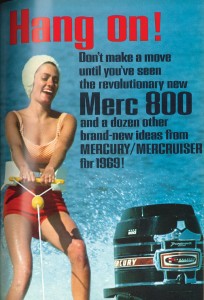 At that time, consumers paid an average of $524 ($4,227.67 in 2014 dollars) for an outboard boat, outboard engines cost an average of $472 and an average new boat trailers cost $220.
At that time, consumers paid an average of $524 ($4,227.67 in 2014 dollars) for an outboard boat, outboard engines cost an average of $472 and an average new boat trailers cost $220.
Brunswick entered the marine industry in 1960 with its purchase of Owen Yachts. In 1961, Brunswick added the Kiekhaefer Corp., builder of the Mercury engine. Other major marine landmarks include the introduction of MerCruiser and its first production sterndrive with more than 100 horsepower, Chris-Craft expanding beyond 10 factories and 5,000 employees, Honda building the first mass-produced four-stroke in 1964 and its first American outboard in 1967, and the Ski Nautique brand reborn with the introduction of a $4,500 boat-trailer combo.
Volvo’s Pentaverken changed its name to AB Volvo Penta in 1965 as marine engine sales grew and the company opened subsidiaries in England, Germany and Italy.
Meanwhile, OMC began overseas production in Brugge, Belgium, introduced four computer-driven sterndrive maintenance schools, entered the snowmobile market in 1964 and, by 1969, saw its annual sales exceed $327 million.
Hurricanes Betsy and Camille were major Gulf Coast disasters that roared ashore in 1964 and 1969.
1970s
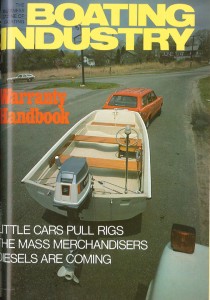 As the 1970s dawned, all eyes were on the poor economy and the pages of The Boating Industry reflected that.
As the 1970s dawned, all eyes were on the poor economy and the pages of The Boating Industry reflected that.
With articles like “Selling in an Uncertain Business Environment” and “Our Uncertain Economy: What Does it Mean to You?” the industry was trying to regain its footing. It’s a pattern that has become all too familiar for the last 40 years.
In 1970, one of the big names in the industry went back out on his own as E.C. Kiekhaefer resigned as president of Mercury and founded Kiekhaefer Aeromarine Motors Inc. He had founded Mercury in 1939 and had stayed on after its acquisition by Brunswick Corp.
There was an increased focus on energy efficiency during the decade, as a series of oil embargoes and gas shortages affected the industry. Most issues of the magazine featured an “Energy Bulletin” and the industry had to withstand attacks on its perceived lack of energy efficiency. The Boating Industry Association and National Association of Engine & Boat created a “Boating Energy Conservation Kit” that dealers could use to promote the “positive values of boating in a fuel-conscious society.”
A new wave of watercraft hit the scene in the 1970s as well, with Kawasaki introducing its first U.S. PWC in 1973. Although Bombardier Recreational Products had introduced a personal watercraft in the late 1960s, it didn’t sell well and the company quickly left the market. It wasn’t until the Jet Ski that PWC became commercially successful.
 The decade also saw an important trend toward more professionalization as two key industry associations were born. First, in 1972, the Marine Retailers Association of America was founded when representatives from more than 50 boat dealers met in Chicago to form the group.
The decade also saw an important trend toward more professionalization as two key industry associations were born. First, in 1972, the Marine Retailers Association of America was founded when representatives from more than 50 boat dealers met in Chicago to form the group.
Then, in 1979, the National Marine Manufacturers Association was formed when the Boating Industry Association and the National Association of Engine & Boat Manufacturers merged after 12 years of negotiations. The merger would help the industry “move forward with a single voice and effort to become more valuable than ever before,” the officers of the new association said.
Boating Industry founder James Peaslee passed away in 1970, and in 1977, the magazine dropped the “The” and became simply Boating Industry.
1980s
In the wake of rising energy prices, unemployment and inflation in the 1970s, the 80s began on rocky shores with two back-to-back recessions. The challenging economic times resulted in bloated inventories, laid-off workers and consumers that were too skittish to invest in a new boat.
Boating Industry reported in 1980 that all eyes were on the Middle East with gasoline topping $1 a gallon.
Major events included the botched U.S. hostage rescue in Iran, the eruption of Mount St. Helens, IBM’s first PC, the assassination of John Lennon, and unsuccessful assassination attempts on the Pope and President Reagan. On the bright side, Pac-Man was released in 1980.
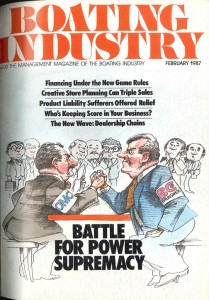 In an article published in the Christian Science Monitor in 1980, NMMA Executive Vice President Frank Scalpone said, “The industry is really taking it on the chin. This year is pretty much beyond redemption for most of the companies. It will probably be one of the worst years ever.”
In an article published in the Christian Science Monitor in 1980, NMMA Executive Vice President Frank Scalpone said, “The industry is really taking it on the chin. This year is pretty much beyond redemption for most of the companies. It will probably be one of the worst years ever.”
The federal government did the industry no favors in the early 80s, either, as the Department of Energy presented plans to ban weekend boating in an effort to save gasoline. The industry organized significant write-in campaigns to protest the ban, which was later scuttled. The DOE’s threats were linked to OMC’s sales falling $54 million in one year.
The recently formed NMMA also launched a promotional campaign telling the economic story of boating, which employed 700,000 people at the time.
Chrysler sold its boatbuilding division to Texas International in 1980.
New York-based AMF stumbled after several failed investments contributed to the company’s losing millions by the year in the early 1980s. Minnesota-based investor, Irwin Jacobs, took over the company in 1985.
Sea Ray and Bayliner became part of Brunswick in 1986, making it the world’s largest producer of marine engines and boats — twice the size of its next largest competitor.
Volvo Penta became an independent subsidiary of the Volvo Group in 1982, as the company increased product launches and product development throughout the decade — notably including the introduction of the Duoprop sterndrive.
A team of investors, including George Dale Murray, purchased Chris-Craft’s boat division in 1981. In 1984 — the same year Yamaha entered the U.S. outboard market — Chris-Craft re-entered powerboat racing with the 300 Chris-Cat catamarans. The following year, Miami Vice character Sonny Crockett appeared aboard a Chris-Craft 390X Stinger, showing America the company’s next generation of performance boats. Chris-Craft parent, Murray Industries, was purchased by OMC in late 1989.
Technological improvements set the stage for industry recovery that picked up as the decade progressed. Mercury brought electronic fuel injection to the industry with the Laser XRi and Mariner Magnum EFI.
1990s
The boating industry was in dire straits as the 1990s started. A crippling luxury tax was passed by Congress in 1990, levying a 10-percent federal tax on boats costing more than $100,000. The early-1990s recession provided a one-two punch that resulted in dozens of bankruptcies and thousands of employees losing their jobs before the tax was finally repealed in 1993.
The industry’s giants were especially hard hit. In 1990, Brunswick closed five plants and laid off nearly 1,000 employees, while Genmar closed two factories. OMC closed more than a dozen plants in the early 1990s. Carolina Skiff, Carver, Ranger, Trojan and Sabre were just some of the brands that went in and out of bankruptcy.
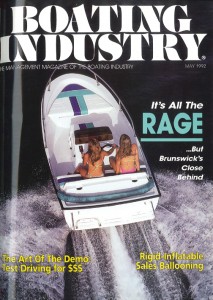 To add insult to injury, 1992’s Hurricane Andrew – at that time the costliest storm in U.S. history – damaged dealerships and marinas in Florida and Louisiana. In 1993, massive flooding in the Midwest devastated businesses in that region.
To add insult to injury, 1992’s Hurricane Andrew – at that time the costliest storm in U.S. history – damaged dealerships and marinas in Florida and Louisiana. In 1993, massive flooding in the Midwest devastated businesses in that region.
Overall, the industry went from employing 600,000 in 1988 to 400,000 in 1992. It was estimated that the average boat price dropped by as much as 50 percent. Sales of boats more than $100,000 dropped by 77 percent, estimated the Marine Retailers Association of America. Boat sales nationally dropped by more than 40 percent from $17 billion in 1989 to $10 billion in 1992.
The luxury tax led to an increased focus on Washington by industry associations and the Congressional Boating Caucus was formed as a formal, bipartisan body to focus on boating issues.
Proving the old adage that there are no new ideas, in 1992 Boating Industry covered the surging jet boat market. Boston Whaler’s 13 ½-foot Rage was generating excitement with more than 450 units shipped, with competition on the horizon from Bayliner, Sea Ray, Yamaha and Sea-Doo.
In other significant events during the 1990s, Textron entered floorplan financing, where it would become a major player until the Great Recession and one of the leading pontoon manufacturers was founded when former Forrester president Bob Menne and dealer Gene Hallberg announced their plans to form Premier Marine. Honda, although it had been selling product in the United States for several years, formed its U.S. marine division, Cummins Diesel formed a marine engine division and Yanmar began building engines in the United States.
Most of the industry recovered in the wake of the tax repeal, with some exceptions. Most notably, OMC continued to struggle, losing market share to other boat and engine manufacturers. In 1996, OMC announced it was considering leaving the boat-building business, although it later reversed course. After saying in 1997 that it was seeking new investors and merger partners after posting large losses for several years, it was acquired by Greenmarine Acquisition Corp., a company affiliated with George Soros. All of that turmoil, of course, foreshadowed the company’s massive bankruptcy in 2000.
2000s
Few decades in American history began as rosy as the 2000s. After the worst of the Asian financial crisis receded, a roaring U.S. economy brought the unemployment rate below 4 percent as investors marched headlong into the Internet bubble that inflated the stock market.
Bucking the positive economic trends, OMC filed for bankruptcy and laid off its 7,000 employees. Bombardier Recreational Production and Minnesota-based Genmar jointly purchased Johnson and Evinrude at auction for $95 million.
Signs of economic weakness appeared across the globe in early 2001, as tensions in the Middle East rose after Israel and Palestine resumed clashes and the U.S. attempted to restart peace talks.
 The world shifted on Sept. 11 with the coordinated Al-Qaeda attacks on the World Trade Center, Pentagon and a fourth hijacked plane that crashed in a Pennsylvania field. Following this tragic turning point, the U.S. economy went into recession. American and British forces quickly launched attacks on targets within Afghanistan. The invasion of Iraq began in March 2003.
The world shifted on Sept. 11 with the coordinated Al-Qaeda attacks on the World Trade Center, Pentagon and a fourth hijacked plane that crashed in a Pennsylvania field. Following this tragic turning point, the U.S. economy went into recession. American and British forces quickly launched attacks on targets within Afghanistan. The invasion of Iraq began in March 2003.
What follows is fairly recent, painful history: ongoing wars in the Middle East, the explosion of Space Shuttle Columbia in 2003, the Indian Ocean earthquake and tsunami in 2004, Hurricane Katrina and its effects on energy prices in 2005, and the financial crisis that began in 2007.
The Great Recession brought unprecedented turmoil to the marine industry as credit dried up, scores lost their jobs, discretionary purchases ground to a halt and many dealers and boat builders struggled to keep the lights on. As annual boat sales fell by more than half, many boat builders large and small shut down, and dealerships — possibly 40 percent of all U.S. dealers— were forced to close their doors.
Genmar Holdings filed for bankruptcy in 2009, and Platinum Equity purchased much of the company, including the Ranger, Glastron and Four Winns brands under the umbrella of its Rec Boat Holdings and Fishing Holding subsidiaries. Irwin Jacobs later reemerged with a partner to purchase Larson Boats in 2010.
At Brunswick, Dustan McCoy was named CEO in 2005, and the company acquired 13 boat brands, nearly doubling the size of its boat group.
Technological innovation helped pull the industry out of its deep funk as the economy gradually improved. Mercury introduced Digital Throttle & Shift Control in 2000 and the FourStroke Verado outboard in 2004. Nautique delivered its SportShift and Hydro-Gate wake technologies, celebrated its 80th anniversary and built a new 217,000-square foot plant in central Florida.
As sterndrive sales remained in the doldrums, pontoons and outboard-powered boats in general became more popular. Although BRP exited the jet boat market with its Sea-Doo brand in 2012, several companies including Rec Boat Holdings (Scarab) and Marine Products Corporation announced plans to enter the jet boat market.





I would like to subscribe as I was the former owner of Typhoon marine boats in Florida as well as Hudson Bay Inflatables. My Father owned Mac’s outboard service through out the 56s and 70s.
Hi Mac,
To fill out a subscription, please click this link: http://epgmediallc.com/subscribe/boating-industry/ and enter the required information. Thank you for your interest in Boating Industry.
Adam Quandt, Associate Editor